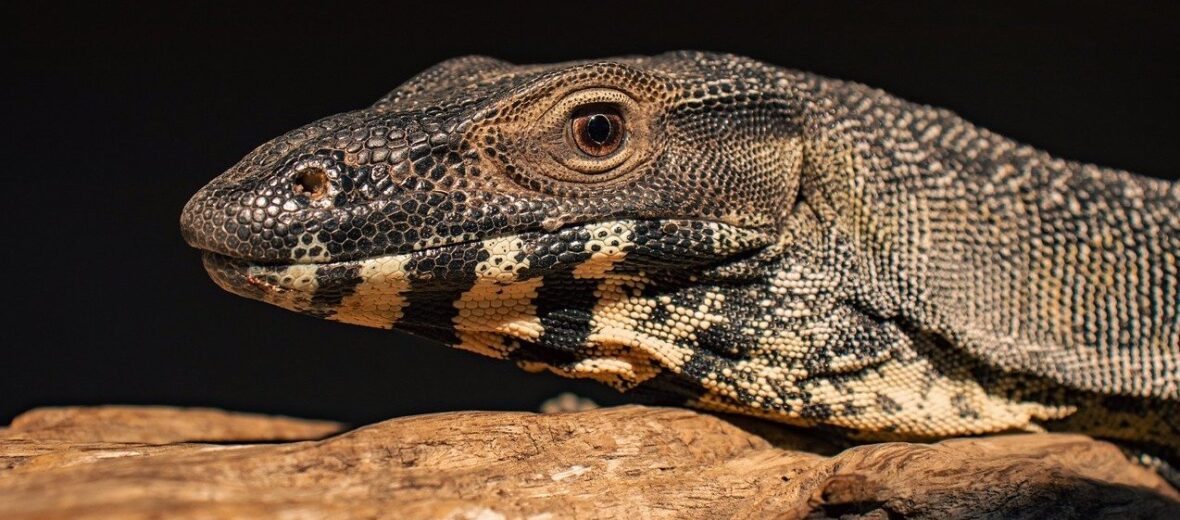
The lace monitor, aka lacy or tree goanna, hails from eastern Australia. These large lizards tolerate cool temperate forests and dry tropical forests. Lace Monitors are a venomous species of lizard with a painful bite. These critters face the threats of fires, fire suppression, and deforestation. However, they have a stable and abundant population and therefore are listed by the IUCN as Least Concern.
First the Stats…
Scientific name: Varanus varius
Weight: Up to 31 lbs.
Length: Up to 6.6 feet, including the tail
Lifespan: Up to 20 years
Now on to the Facts!
1.) While mostly terrestrial (spend their life on the ground), these monitors, like many others, can climb trees very well, even though they are large and seem cumbersome.
2.) Lace monitors are diurnal (active during the day).
3.) Like many other lizards, they are solitary and only come together to mate.
4.) That being said, a group of lizards is called a lounge.
5.) They are notorious for attacking chickens and their eggs.
But wait, there’s more on the lace monitor!
6.) Laceys are also known for raiding picnic sites and campgrounds for edible trash left unattended by humans.
7.) These lizards are mostly active from September – May, and brumate (hibernation for reptiles) the rest of the year under logs or in tree hollows.
Did you know…?
It was discovered in 2005 that all monitor lizards are, to a degree, venomous. A bite on your hand has been observed to cause swelling within just minutes, local disruption of blood clotting, and searing pain up to the elbow. This can typically last for up to several hours.
8.) Their venom can also affect platelet count, relax smooth muscle tissue, and cause a drop in blood pressure.
9.) It was, at 1 time, thought that their bite was dangerous due to their cryptosporidic saliva. This theory was later disproven. Yes, their bite is definitely dirty and can cause infections, but it’s their venom that causes the true threat.
10.) Males routinely fight, during mating season, to win breeding rights. Fights consist of intimidation via an inflated throat sac, standing on their hind legs to appear larger, and knocking one another over.
But wait, there’s still more on the lace monitor!
11.) Females lay up to 12 eggs that hatch in up to 7 months.
12.) Eggs are laid in abandoned termite mounds. If these mounds are hard to find, the females too will fight, but for nesting rights.
Did you know…?
In searching for food, these lizards can trek upwards of 1.9 miles in a single day.
13.) Like all lizards, the hatchlings are born precocial (self sufficient). But they will hang around the nest site for about a week before dispersing.
14.) Insects, other reptiles, small mammals, birds, eggs, carrion (dead animals), and human trash are all on the menu for these carnivorous scavengers.
15.) Lace monitors are the 2nd largest monitor lizard in Australia, after the perentie.
But wait, there’s still a little more on the lace monitor!
16.) The Eora and Darug people of Sydney call these lizards ‘wirriga.’ The Wiradjuri people of southern New South Wales call them ‘gugaa.’
17.) These lizards are not migratory. Quite the contrary. 1 monitor was documented living in the same tree for several years.
18.) Younger and subsequently smaller lace monitor lizards spend more time in trees than adults. This is believed to be because of the potential for predation and/or cannibalism.
19.) Due to their frequent attempts to steal tasty turkey eggs, lace monitors are often scarred on their body and tail due to turkeys pecking at them to drive them off.
20.) Birds of prey, dingoes, and larger monitors are their primary predators.
Now a Short Lace Monitor Video!
Be sure to share & comment below! Also, check out the Critter Science YouTube channel. Videos added regularly!
Want to suggest a critter for me to write about? Let me know here.
Some source material acquired from: Wikipedia and IUCN



